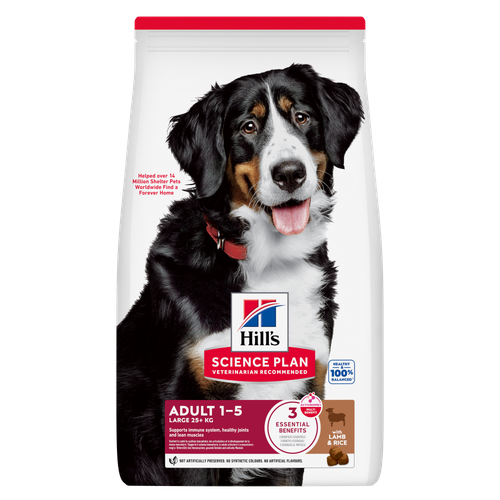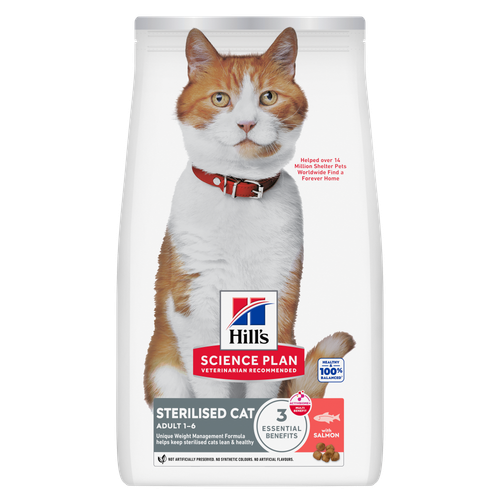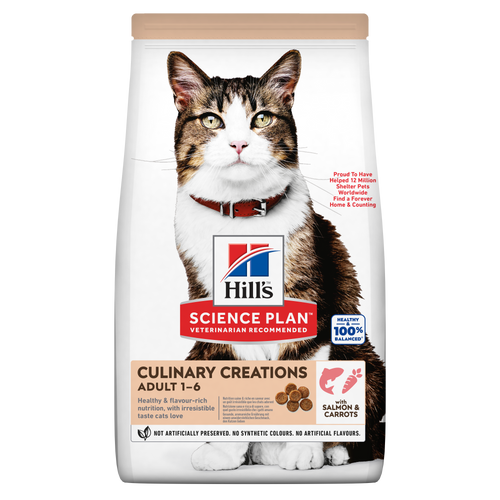
-
Find the right food for your petTake this quiz to see which food may be the best for your furry friend.Find the right food for your petTake this quiz to see which food may be the best for your furry friend.Featured products
 Adult Light Dog Food
Adult Light Dog FoodHill's Science Plan Light Adult Wet Dog Food is a complete premium pet food for adult dogs that tend to gain weight easily. This deliciously smooth loaf is formulated to deliver the appropriate amount of energy to support weight maintenance in adult dogs.
Shop Now Perfect Digestion Large Breed Puppy Food
Perfect Digestion Large Breed Puppy FoodPrecisely balanced nutrition with Hill's ActivBiome+ prebiotic blend actively contributes to supporting digestive health and overall wellbeing to help your pet feel their best
Shop Now Large Breed Adult Dog Food
Large Breed Adult Dog FoodHill's Science Plan Large Breed Adult Dog Food with Lamb & Rice is a complete pet food, specially formulated with ActivBiome+ Multi-Benefit Technology.
This food is specifically designed to fuel the energy needs of large breed dogs during the prime of their life.Shop NowFeatured products Sterilised Adult Cat Food
Sterilised Adult Cat FoodHill's Science Plan Adult Sterilised Cat Dry Food with Salmon is specially formulated with ActivBiome+ Multi-Benefit Technology. It is a precisely balanced nutrition, tailored to meet the needs of sterilised cats, to help keep sthem lean & healthy.
Shop Now Adult Cat Food
Adult Cat FoodHill's Science Plan Adult Cat Food with Chicken is a complete pet food, specially formulated with ActivBiome+ Multi-Benefit Technology.
This food is specially formulated to fuel the energy needs of cats during the prime of their life.Shop Now CULINARY CREATIONS ADULT CAT FOOD
CULINARY CREATIONS ADULT CAT FOODHill's Science Plan CULINARY CREATIONS Adult cat food with Salmon & Carrots was formulated to provide a great-tasting experience to cats. Its delicious flavour and texture are combine with essential nutrients to support cats' optimal health during the prime time of their life. Specially formulated with high-quality salmon protein, essential taurine for heart health & balanced minerals to support kidneys & bladder.
Shop Now -
Dog
- Dog Tips & Articles
-
Health Category
- Weight
- Food & Environmental Sensitivities
- Urinary
- Digestive
- Joint
- Kidney
-
Life Stage
- Puppy Nutrition
- Adult Nutrition
- Senior Nutrition
Cat- Cat Tips & Articles
-
Health Category
- Weight
- Skin & Food Sensitivities
- Urinary
- Digestive
- Kidney
-
Life Stage
- Kitten Nutrition
- Adult Nutrition
Featured articles Pet Nutrition: What Makes "Healthy" Pet Food Healthy? | Hill's Pet
Pet Nutrition: What Makes "Healthy" Pet Food Healthy? | Hill's PetIn people, the right diet is very important. If you are eating the wrong way for your metabolism, activity level, age and lifestyle you could end up with health issues.
Read More The Incredible Science Behind Your Pet's Microbiome
The Incredible Science Behind Your Pet's MicrobiomeLearn what your pet's microbiome is, how it contributes to your pet's gut and overall health, and why nutrition is important in maintaining healthy microbiomes.
Read More Microchipping: The Facts | Hill's Pet
Microchipping: The Facts | Hill's PetThe government has announced that as of April 2016, all dogs in the UK must be microchipped by law.
Read More -


Related Image Content
Skin allergies are not uncommon in pets and the same pollens and house dust that cause allergic reactions in people can have the same effect on dogs. Allergic dermatitis is an inflammation of the skin and can be brought on by many things, but the end results are generally the same; an uncomfortable dog who can't stop licking and scratching. In extreme cases there may even be hair loss.

IMPORTANT: Skin discomfort can have many causes. If your dog is showing signs of irritation, consult your veterinarian who will be able to diagnose the condition.
What can you do?
Your vet may try to help manage your dog's allergy by numerous methods including injections, oral medications, nutritional management, topical shampoos, dips, ointments and environmental treatments.
At home, you can provide plenty of clean water (your vet may even recommend distilled water). If your vet has performed a biopsy or prescribed a medicine, be certain to closely follow instructions for care and activity restrictions. Use environmental sprays and foggers only as directed and watch your dog closely for signs that the condition is recurring.
Do not hesitate to call the clinic if questions or problems arise.
IMPORTANT: Skin discomfort can have many causes. If your dog is showing signs of irritation, consult your veterinarian who will be able to diagnose the condition.


Tasty Tips
Food for thought
Nutrition can help dogs with food allergies and dietary fatty acid therapy has been used in dogs with allergic skin disease or dogs with pruritis or dermatitis.
There are a few different foods available depending on how bad the allergy is. Discover more about the benefits of Hills™ Science Plan™ Sensitive Skin pet food for your dog or consult your veterinarian about the effectiveness of Prescription Diet therapeutic pet foods.
Flea Control
If your dog is allowed outdoors, complete elimination of fleas is almost impossible. A more realistic goal is flea control, especially in warmer parts of the country. This requires controlling the life cycle of the flea with one of the highly effective topical or oral products available today. Your vet will recommend which is most appropriate for your dog and household.
Environmental treatment is also important in flea control. Frequent vacuuming removes flea eggs in rugs and carpeting (promptly dispose of the vacuum bag). Laundering your dog's bedding is also advised. Sprays may also be recommended by your veterinarian. Preventative measures taken before you see fleas can save you and your dog a lot of discomfort.
Ticks
Ticks spread diseases such as Lyme Disease and people and pets can contract these diseases, so ticks are a serious concern. If dogs live in or visit countryside areas they should be checked for ticks.
As far as possible keep your dog from roaming through tall grasses and woods. If you have been out walking in those areas have a look for small lumps on the skin (similar to a wart).
Prompt removal can prevent the spread of tick-borne illness. Take your dog along to the vet who will be able to remove it with the correct equipment as you don't want to break it and leave some of the tick behind.


One of our staff authors prepared this article for you
Related products

Hill's Science Plan Adult Wet Dog Food with Turkey is a complete premium pet food for adult dogs from 1 year. This deliciously smooth minced turkey loaf is formulated to deliver the appropriate amount of energy to support the needs of adult dogs.

Hill's Science Plan Large Breed Adult Dog Food with Lamb & Rice is a complete pet food, specially formulated with ActivBiome+ Multi-Benefit Technology.
This food is specifically designed to fuel the energy needs of large breed dogs during the prime of their life.

Hill's Science Plan Light Adult Wet Dog Food is a complete premium pet food for adult dogs that tend to gain weight easily. This deliciously smooth loaf is formulated to deliver the appropriate amount of energy to support weight maintenance in adult dogs.

Precisely balanced nutrition with Hill's ActivBiome+ prebiotic blend actively contributes to supporting digestive health and overall wellbeing to help your pet feel their best
Related articles

Learn to see the signs of an upset stomach in your dog, understand the triggers and explore some possible solutions.

Dog obesity is a significant problem - learn more about helping your dog become trimmer and healthier through improved nutrition.

Gurgling tummies in turmoil are not good news for pets. Owners who have to clean up the unfortunate consequences, digestive problems are one of the rare downsides to owning a pet.
Discover the causes, signs, and treatments of kidney disease in dogs and find methods of supporting your dog's kidney health. Learn more at Hill's Pet.

Put your dog on a diet without them knowing
Our low calorie formula helps you control your dog's weight. It's packed with high-quality protein for building lean muscles, and made with purposeful ingredients for a flavourful, nutritious meal. Clinically proven antioxidants, Vitamin C+E, help promote a healthy immune system.
Put your dog on a diet without them knowing
Our low calorie formula helps you control your dog's weight. It's packed with high-quality protein for building lean muscles, and made with purposeful ingredients for a flavourful, nutritious meal. Clinically proven antioxidants, Vitamin C+E, help promote a healthy immune system.

